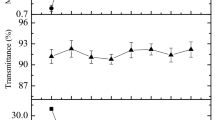Abstract
Recently, there has been pronounced interest in polymer blends. Different types of polymer blends of two or more are mixed to create new type of polymer with different physical properties. Common type of high-density polyethylene (HDPE) is selected and has been mixed with biopolymer. Two different forms of biopolymers, that is, particle biopolymer and liquid biopolymer were mixed with HDPE, namely as HP and HL, respectively. The ratio of both biopolymer form is at 5, 10, 15, 20, 25 and 30% weight by weight percentage ratio (wt/wt) of HDPE. This is to study the processing condition and compatibility of HDPE with biopolymer in different form. HP and HL were mixed by using Brabender Plastograph machine complete with mixer and roller screw. The mixture of HP and HL were then injected into dumbbell shape of tensile specimen using injection moulding. Next, the specimen of tensile was exposed to the ultraviolet exposure for 3000 h in Ultraviolet Weatherometer chamber. The physical and mechanical properties of both forms of blended polymers were tested. The tensile strength of all ratios of HL shows higher mechanical strength as compared to HP. Meanwhile, Melt Flow Index (MFI) of HP shows higher value for all percentage ratios loading as compared to HL. This shows that the liquid form of biopolymer mixed with HDPE gives stronger intermolecular forces, which attracts polymer molecules towards each other. The liquid form of biopolymer was crosslinked and chemically joined together in places, by creating branched, or network structure. High crosslinked bonds in the polymer molecules hold the groups of polymer chains together to form stronger new types of polymeric material of HL.
Access this chapter
Tax calculation will be finalised at checkout
Purchases are for personal use only
Similar content being viewed by others
References
Callister WD (2005) Fundamentals of materials science and engineering, 2nd edn. Wiley, Hoboken
Geoffroy R (2004) Using melt flow rate to determine change in molecular weight. http://www.eng-tips.com/faqs.cfm?fid=969. Accessed 15 July 2016
Ghani KZA, Rus AZM (2013) Influence of hot compression moulding of biopolymer filled waste granulate biopolymer. Appl Mech Mater 315:448–452
Hassan NNM, Rus AZM, Nurulsaidatulsyida S (2013) Acoustic study based on sustainable green polymer treated with H2O. Adv Mater Res 748:281–285
Ibrahim BA, Kadum KM (2010) Influence of polymer blending on mechanical and thermal properties. Mod Appl Sci 9(4):157
Kaplan D (1998) Biopolymers from renewable resources. Springer, Berlin
Kuitian T, Obendorf SK (2007) Hybrid microporous membranes intended for protective clothing. In: 15th National Textile Center Conference, Hilton Head Island, South Carolina
Mohd Rus AZ (2009a) Effect of titanium dioxide on material properties for renewable rapeseed and sunflower polyurethane. Int J Integr Eng 1(1):15–22
Mohd Rus AZ (2009) Material properties of novelty polyurethane based on vegetable oils. In: The 11th International Conference on QiR (Quality in Research), Depok, Indonesia
Mohid SR, Rus AZM, Harun NH (2013) Influence of biopolymer composites as heat absorption coating. Appl Mech Mater 315:404–407
Shah AA, Hasan F, Hameed A, Ahmed S (2008) Biological degradation of plastics: a comprehensive review. Biotechnol Adv 26:246–265
Williams CK, Hillmyer MA (2008) Polymers from renewable resources: a perspective for a special issue of polymer reviews. Polym Rev 48(1):1–10
Zhang S, Cao XY, Ma YM, Ke YC, Zhang JK, Wang FS (2011) The effects of particle size and content on the thermal conductivity and mechanical properties of Al2O3/high density polyethylene (HDPE) composites. eXPRESS. Polym Lett 5(7):581–590
Acknowledgements
The authors would like to thank the Head Principal Researcher of Sustainable Polymer Engineering, Advanced Materials and Manufacturing Center (SPEN, AMMC), Universiti Tun Hussein Onn Malaysia (UTHM), Johor for providing raw materials and facilities and Malaysian Government for supporting this research under Fundamental Research Grant Scheme, FRGS Vot 1481.
Author information
Authors and Affiliations
Corresponding author
Editor information
Editors and Affiliations
Rights and permissions
Copyright information
© 2018 Springer Nature Singapore Pte Ltd.
About this paper
Cite this paper
Sulong, N., Mohd Rus, A.Z. (2018). Processing and Compatibility of High-Density Polyethylene Blended with Particle and Liquid Biopolymer on Ultraviolet Exposure. In: Yacob, N., Mohd Noor, N., Mohd Yunus, N., Lob Yussof, R., Zakaria, S. (eds) Regional Conference on Science, Technology and Social Sciences (RCSTSS 2016) . Springer, Singapore. https://doi.org/10.1007/978-981-13-0074-5_45
Download citation
DOI: https://doi.org/10.1007/978-981-13-0074-5_45
Published:
Publisher Name: Springer, Singapore
Print ISBN: 978-981-13-0073-8
Online ISBN: 978-981-13-0074-5
eBook Packages: Business and ManagementBusiness and Management (R0)




